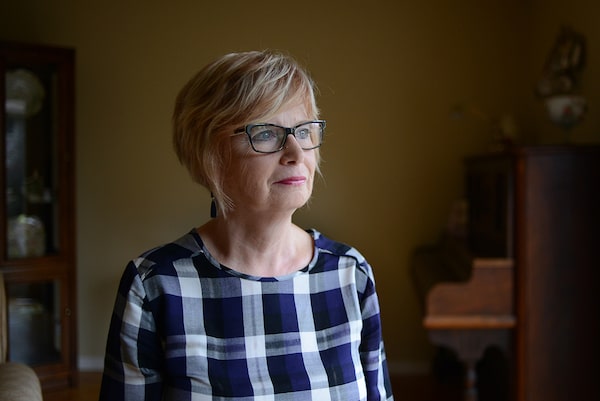
As an advocate for improved pain management in Canada, Lynn Cooper advises patients to access a multidisciplinary team of health practitioners. It's an approach she also takes to help manage the physical and emotional challenges of her own chronic pain.Ian M. Stewart/The Globe and Mail
While most Canadians are aware of the prevalence of both chronic pain and mental illness, the frequency with which the two are connected is less understood.
It’s something Lynn Cooper, a resident of Kitchener, Ont., has learned from both her own experience and her work as an advocate for improved pain management in Canada. As a young woman just launching her career, Cooper severely injured her back and foot while at work. That acute pain eventually turned into a chronic condition, which led to depression.
“The stress of chronic pain is a huge thing,” says Cooper. “If you’ve ever had a headache or acute pain that’s been significant, imagine if that never went away. Imagine the stress levels, and any kind of stress is going to exacerbate the pain. So within the pain cycle you have all kinds of emotions and all of that impacts your mood.”
The Canadian Mental Health Association reports that people with chronic physical conditions experience depression and anxiety at twice the rate of the general population.
Witnessing firsthand the psychological toll of chronic pain during his decades of experience as both a chiropractor and in counselling psychology, Dr. Wayne Coghlan, who practices in Vaughan, Ont., recognizes the importance of connecting the dots between physical and emotional conditions.
“If you want to get better, you have to work your way forward,” says Dr. Coghlan, who encourages his patients to not only keep moving, but to find new ways to modify their thinking and attitude. “I’m trying to put the seed in the person’s mind that maybe things aren’t as doomy and gloomy as they think. Maybe there’s a way through this by taking one step at a time.”
An important component of chiropractic care involves providing patients with self-management education and coping strategies, including goal setting and prescribing therapeutic exercises to help manage muscle, bone, tendon, ligament and joint conditions.
Dr. Coghlan’s mantra to newly injured patients is “motion is lotion.” While it’s common to feel sore and frightened when experiencing pain or an injury, and patients want to rest, taking it easy for too long can turn that muscle and joint stiffness and achiness into chronic pain — and often a downward spiral into depression and anxiety. Motion can help prevent that from happening and research demonstrates that exercise can be effective in helping manage both mental health conditions and muscle and joint problems, such as low back pain.
Teasing out where the depression or anxiety begins and the chronic pain ends can be tricky though, says Samantha Fuss, a psychologist at the Work, Stress and Health Program at the Centre for Addiction and Mental Health (CAMH) in Toronto. Pain can cause mental illness, and sometimes mental illness causes pain. In fact, some studies suggest that about half of all people with depression who visit their doctor complain only about their physical symptoms, not their emotional distress. “There’s a lot of overlap of symptoms between chronic pain and depression and anxiety,” says Fuss. “Things like disturbed sleep, low energy levels, worry or rumination, and hopelessness. Those can occur with each type of condition.”
Says Fuss: “It can be really beneficial to explore helpful coping strategies to manage pain, especially given that sometimes there’s not a cure for it. This is about improving quality of life and continuing to have meaning and a sense of purpose in the context of a chronic condition.”
Cooper teaches people at the Hamilton Health Sciences Chronic Pain Management Unit to create a “pain plan” that involves accessing multidisciplinary pain management, including doctors, chiropractors, social workers, psychologists, dietitians, occupational therapists and more. But Cooper regrets that most much-needed help is not fully covered by government or company health plans. For many of the services, she says she saves up and pays out of pocket. “Health care providers that you consult over your lifetime with chronic pain can change depending on your needs,” she advises. “And what works for one person doesn’t necessarily work for another. That’s why we need to have access to as many options as possible.”
Each patient is the most important person in the equation, though, and his or her actions can mean the difference between living as well as possible under the circumstances and suffering. Cooper likes to create goals and adjustments to plans that may cause stress so she can enjoy life more.
For example, rather than deciding she can’t travel because of pain, Cooper builds in rest periods before and after flights.
“You’ll have good days and not so good days,” she likes to tell other people dealing with persistent pain. “We have to recognize that and forgive ourselves through the challenging times. But it is possible — and there is hope.”
What are the symptoms?
If you have some of these symptoms, you may be suffering from depression or anxiety in addition to chronic pain. To help ease the burden, reach out to your health care providers.
- Changes in appetite and weight
- Sleep problems
- Loss of interest in activities
- Withdrawal from family and friends
- Feeling useless, hopeless or excessively guilty
- Agitation or feeling slowed down
- Fatigue
- Trouble concentrating
- Irrational and excessive fear
- Apprehensive and tense feelings
- Avoidance of feared situations
- Racing heart
- Thoughts of suicide (which should always be taken seriously)
Source: The Centre for Addiction and Mental Health (CAMH)
Advertising feature produced by Globe Content Studio. The Globe’s editorial department was not involved.